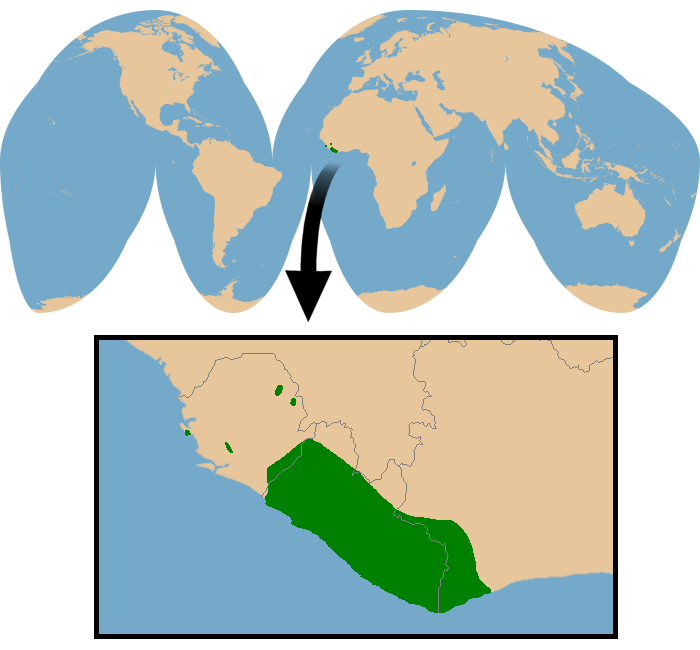Kingdom: |
Animalia Chordata Mammalia Artiodactyla Ruminantia Bovidae Cephalophinae Cephalophus |
Common name:
Scientific name:
Other names: |
Jentink's duiker
Cephalophus jentinki
Céphalophe de Jentink, Jentinks Ducker, Duiquero de Jentink, Gidi-gidi, Gri-gri, Kaikulowuli or Kaikulowulei, Dikidiki, Nienagbé, Nyonoploo-Nynabeh |
Physical Characteristics
- Head and body length:
135 cm
- Shoulder height: 80 cm
- Tail length: 15 cm
- Adult weight: 57-80 kg
- Shoulder height: 80 cm
The coloration of Jentink's duiker is distinctive and unique: the head and neck are glossy black, and the body is grizzled gray. A thin band of whitish hair runs around the shoulders and lower chest, separating the black forequarters from the gray body; the legs are similarly pale in color. The lips are pale, but the predominant facial feature is the slit in front of each eye which holds a glandular patch. There is no tuft of hair on the forehead. Both males and females have sturdy spike-like horns - in mature individuals, these are 14-21 cm long and slope backwards from the forehead.
- Similar species
- The yellow-backed duiker (Cephalophus silvicultor) is the only duiker of similar size that lives in West Africa. Although adult Jentink's duikers are easily distinguished by their black and gray coats, juveniles of the two species are very similar.
- The coloration of the Asian tapir (Tapirus indicus) is superficially similar, but the elongated proboscis, black legs, and much larger size of the tapir readily distinguish it from Jentink's duiker.
Reproduction and Development
- Gestation period:
Probably 8 months.
- Litter size: One.
- Weaning: Unknown. Probably 3-4 months.
- Sexual maturity: Unknown.
- Life span: Up to 21 years.
- Litter size: One.
Very little is known on the breeding patterns of Jentink's duiker. Infants are dark brown at birth, and do not obtain the black-and-gray coloration of adults until one year of age.
Ecology and Behavior
- Family group:
Solitary.
- Diet: Primarily leaves and stems; also fruit when available.
- Main Predators: Leopard.
- Diet: Primarily leaves and stems; also fruit when available.
Habitat and Distribution

Conservation Status
- IUCN Red List:
Endangered (2008).
- CITES Listing: Appendix I (2011).
- Threats: Habitat loss, hunting.
- CITES Listing: Appendix I (2011).
The estimated total population is no more than 3,500 individuals; some experts believe that fewer than 2,000 remain.






